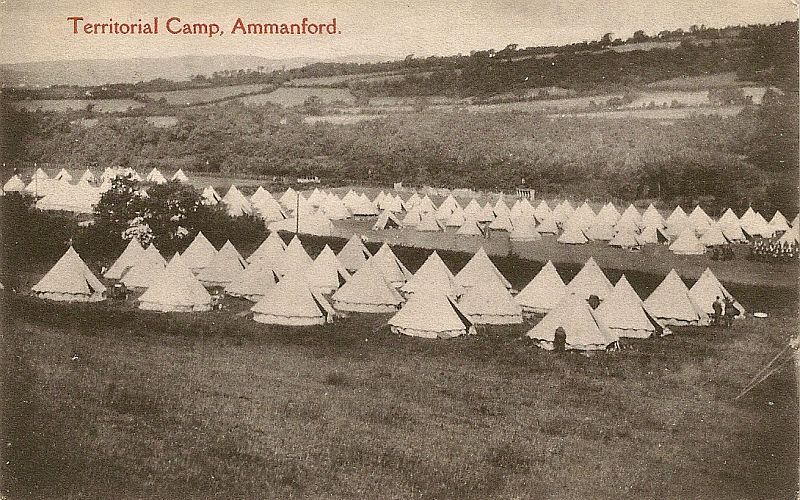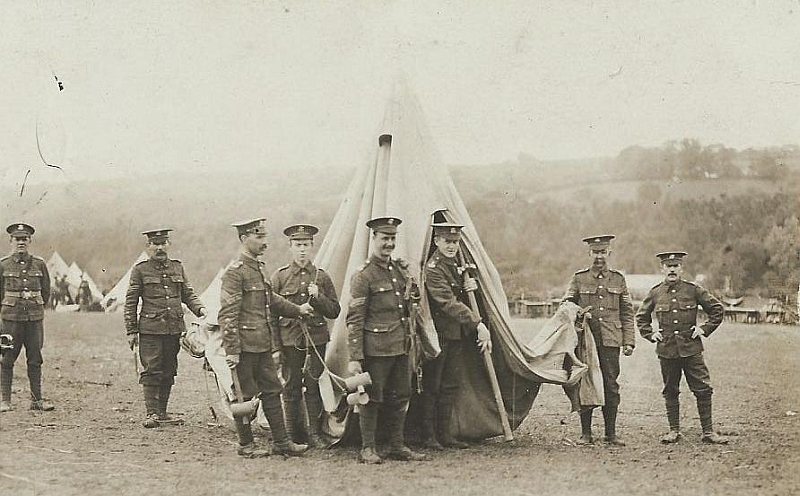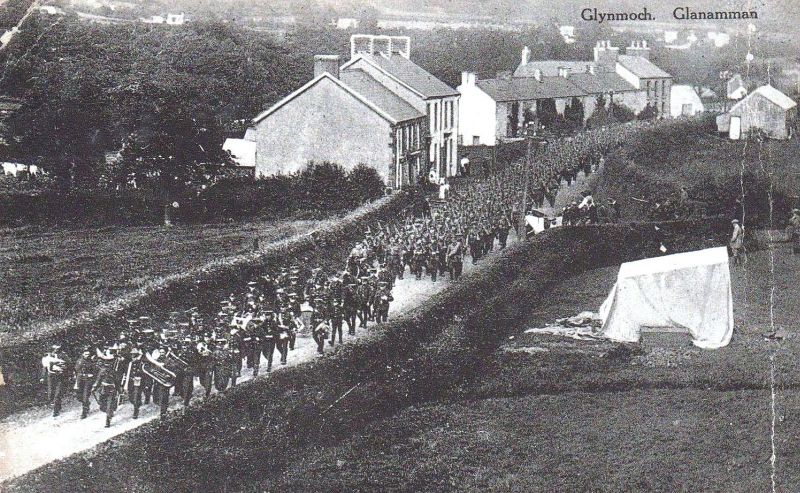PeopleOf CwmammanTerritorial Force CampThe above image shows the Territorial Force Camp which would have been a dramatic sight for the people of Cwmamman during its presence between 25th of July and the 8th of August, 1909. It was situated in the fields near Glynmoch between Glanamman and Pontamman, on both sides of the main road, on land which formed parts of Ystradamman Farm and Glynmoch Farm. The Territorial and Reserve Forces Act of 1907 saw the establishment of County Associations responsible for the training and equipping of their county's Territorial Force units. The Carmarthenshire association of the Territorial Force volunteers were an infantry and cyclist battalion which held the title of 1st Pembrokeshire Volunteer Battalion. This formed part of the 4th Battalion of The Welsh Regiment. The Lord Lieutenant was usually president of their County Association and at the time that the above photograph was taken, the Lord Lieutenant of Carmarthenshire was Sir James Williams-Drummond, 4th Baronet. On a national level, the Territorial Force was established in 1908 and became the Territorial Army in 1920. The 20th of March 1908 edition of the Cambrian Newspaper reported that a meeting had been held at the Ivorites Hall, Ammanford on Friday the 13th of March where the new army scheme was explained to the volunteers. Captain Roberts of Llandeilo presided and Colonel Morris of Brinffin (Colonel Rd, Betws) was also in attendance and stated that he would be holding a meeting at Garnant with the intention of "raising a section of engineers there". On the 8th of May 1980, the Cambrian reported that the first Welsh field company Royal Engineers would be formed and based at Llanelly. This was to comprise of two sections; the Carmarthen One section and the Amman Valley One section.. Sergeant-Major Brown formerly of the Birkenhead Volunteer Engineers had been appointed sergeant instructor and was to commence his duties the following week. Other officers appointed by that time were Major R.A. Neville and Captain Jack Francis. The 30th of July 1909 edition of the Carmarthen Journal reported that crowds of people had gathered along the road to watch the South Wales Brigade march to the camp, each regiment being headed by their respective band. The first to arrive were the company from Llandeilo who reached Ammanford Railway Station at 10am. An hour later, the 6th Welsh arrived in two trains, followed by the 2nd Monmouthshire Battalion, the 4th and 5th Welsh, with two sections of the 1st Monmouthshire arriving by 4:30pm.
The 1st Welsh Regiment had left Pembroke Dock on Monday the 26th of July and were camped between Pantyffynon and Ammanford. It was stated that these were "regulars" and were there for "their own purposes and their own training" but would occasionally act in concert with the Ammanford Camp Territorials. Excluding the regular soldiers, the number of men from each group who were at Ammanford Camp on the first week is as follows:
As well as the four brigades named above, the 4th Battalion Welsh from Haverfordwest, numbering 650 men were also at the camp. Including the regulars, it was estimated that there were approximately 4,000 men at Ammanford Camp in the first week. The Army Service Corps were about 100 strong and had handled around 300 tons of equipment in three days with only six carts. Officers of our 4th Battalion who were present at the camp were:
On Wednesday the 4th of August 1909, thousands of troops were engaged in manoevres and this was reported in the 6th of August 1909 edition of the Cambrian. The weather had up until this point been so poor that the Brigadier (Colonel Rees Banfield) after consulting General Lloyd (who was in command of the Welsh division) had come to the decision that the camp should be broken up. The weather, however, improved dramatically and this meant that the manoevres were able to go ahead. Lieutenant-General Burnett (of the Western Command) was present, while General Lloyd was chief umpire. The scenario saw Colonel Rees Banfield commanding nearly 3,000 men of the South Wales Infantry Brigade who took the role of an attacking force that had landed at Swansea and was advancing from the direction of Garnant via Llandeilo Road. The attackers consisted of the 1st and 2nd Monmouth and the 5th and 6th Welsh. Colonel Schofield was in charge of the defending force which consisted of the Welsh Regiment (the Regulars) and the 4th Battalion. These were expected to stop the attacking force, whom in this instance they could expect to encounter on the Black Mountain. Despite the attackers having the benefit of hedges and stone walls for cover, the chief umpire, General Lloyd, noted that the attack in general failed due to a lack of communication between the several units of the brigade and he remarked that the front line was not the place for the commanding officer or the signalling. After the men had returned to camp, General Lloyd also remarked on other issues which did not meet with his approval. He noticed that some of the men had decorated their hats with flowers which he regarded as very unsoldierly and some had worn unofficial colours. A Maxim Gun was brought into camp by a man on a horse. General Lloyd did not approve of the fact that there were two men riding on the gun! Otherwise, both General Lloyd and General Burnett were pleased with the immense improvement that had been made through company training. The Cambrian's 13th of August 1909 edition held another article regarding Ammanford Camp. It was reported that on Thursday the 5th of August, the five Battalions had climbed the Betws Mountain in oppresive heat and there, another attack and defense drill was carried out for around three hours before the men marched off to camp by around 1pm. Later, Brigadier Banfield told the Cambrian that the previous week had brought some of the worst camping weather that he had ever seen and that the whole of the camp on the southern side of the road had been turned into a quagmire by the heavy rain. Narrow planks of wood were used when available, to enable movement from one part of the camp to another but some parts were under one or two feet of water. This had inevitably interfered with the work in camp. The previous Friday's manoevres started at 8am with outpost advance guard duty. The recent heatwave had resulted in three or four men suffering from mild sunstroke. Boxing matches had also been taking place at the camp. The Cambrian also reported in its 13th of August 1909 edition, that the "South Wales Infantry Brigade Camp" had ended on Sunday the 8th, having lasted two weeks. The reveille had sounded at 4am and the 1st Monmouthshire Battalion were the first to march out of the camp at 6:30am. The various bands could be heard playing the fairwell march until well into the afternoon as each group left.
The Territorial Force marching through Glynmoch, Glanamman with the band leading the parade. Information for this page was taken from the Carmarthen Journal and Cambrian newspapers as stated in the article and also various articles on the Wikipaedia website. |


